What'sNEW Archives, March-April 2003
April 23
 SARS from space? Fred Hoyle and Chandra Wickramasinghe have proposed that new respiratory diseases often come from China for an interesting reason: if viruses come from space, winds that rise over Earth's highest mountains, the Himalayas, and then descend onto the plain of China would be likely to deliver them there first. Severe acute respiratory syndrome (SARS), the newset disease from China, might exemplify this phenomenon. The case is speculative, but interesting. [Thanks, Robert Cobb and Alan Boyle.]
SARS from space? Fred Hoyle and Chandra Wickramasinghe have proposed that new respiratory diseases often come from China for an interesting reason: if viruses come from space, winds that rise over Earth's highest mountains, the Himalayas, and then descend onto the plain of China would be likely to deliver them there first. Severe acute respiratory syndrome (SARS), the newset disease from China, might exemplify this phenomenon. The case is speculative, but interesting. [Thanks, Robert Cobb and Alan Boyle.]
 Is bug from outer space?, by Tim Spanton, The Sun, 23 Apr 2003. Is bug from outer space?, by Tim Spanton, The Sun, 23 Apr 2003.
 SARS from the stars?, by Alan Boyle, MSNBC News, 23 Apr 2003. SARS from the stars?, by Alan Boyle, MSNBC News, 23 Apr 2003.
 Fred Hoyle and Chandra Wickramasinghe, p 99, Cosmic Life-Force, New York: Paragon House, 1990. Fred Hoyle and Chandra Wickramasinghe, p 99, Cosmic Life-Force, New York: Paragon House, 1990.
 Influenza from Space is a related CA webpage with discussion from an earlier eruption of this controversy. Influenza from Space is a related CA webpage with discussion from an earlier eruption of this controversy.
April 16
Point mutations are less important than rearrangements of longer DNA strands in evolution, according to two recent scientific articles. Working with yeast, an English team found that "swapping large chunks of genetic material might spur the split of one species into two." And a US group reports that insertions and deletions averaging 36 nucleotides in length account for three times as many unmatched nucleotides as base substitutions do, when chimpanzee and human DNA is compared. This shift in thought, compelled by the new evidence from genome sequencing, is not minor, we believe. Do darwinists now hold that the swapping of long strands of DNA gradually composes new genetic programs needed for evolutionary advances? If so, how? Or, as we suggest, is the swapping process needed for proper installation of new genetic programs that have been acquired by horizontal gene transfer? [Thanks, Hans-Peter Wheeler.]

 Daniela Delneri et al., "Engineering evolution to study speciation in yeasts" [abstract], p 68-72 v 422 Nature, 6 Mar 2003. Daniela Delneri et al., "Engineering evolution to study speciation in yeasts" [abstract], p 68-72 v 422 Nature, 6 Mar 2003.
 Ken Wolfe, "Evolutionary biology: Speciation reversal," p 25-26 v 422 Nature, 6 Mar 2003. Ken Wolfe, "Evolutionary biology: Speciation reversal," p 25-26 v 422 Nature, 6 Mar 2003.
 Gene reorder may drive evolution, by Lidia Wasowicz, UPI, 5 Mar 2003. Gene reorder may drive evolution, by Lidia Wasowicz, UPI, 5 Mar 2003.

 Roy J. Britten et al., "Majority of divergence between closely related DNA samples is due to indels" [abstract], p 4661-4665 v 100 Proc. Natl. Acad. Sci. USA, 15 Apr 2003. Roy J. Britten et al., "Majority of divergence between closely related DNA samples is due to indels" [abstract], p 4661-4665 v 100 Proc. Natl. Acad. Sci. USA, 15 Apr 2003.
 Neo-Darwinism... is a related CA webpage. Neo-Darwinism... is a related CA webpage.
 Viruses... is a CA webpage about horizontal gene transfer and related phenomena. [Next-What'sNEW about HGT-Prev] Viruses... is a CA webpage about horizontal gene transfer and related phenomena. [Next-What'sNEW about HGT-Prev]
April 11
The Wall Street Journal looks at cosmology in today's "Science Journal" column. Apparently, following recent revelations by the Wilkinson Microwave Anisotropy Probe (WMAP), a few cosmologists are depressed because they think so little remains to be discovered. But some intriguing possibilities are still alive, Sharon Begley notes. She specifically mentions a universe that cycles eternally instead of springing from nothing.

 Sharon Begley, "Do Not Despair: Mysterties of Cosmos Not All Solved," p B1, The Wall Street Journal, 11 April 2003. Sharon Begley, "Do Not Despair: Mysterties of Cosmos Not All Solved," p B1, The Wall Street Journal, 11 April 2003.
 The End and the Big Bang is a related CA webpage. The End and the Big Bang is a related CA webpage.
 Gabriel Manzotti comments, 12 Apr 2003. Gabriel Manzotti comments, 12 Apr 2003.
April 7
The origin of innovations might be based on different mechanisms than the steady, quantitative changes underlying variation — Gerd B. Müller (p 829).
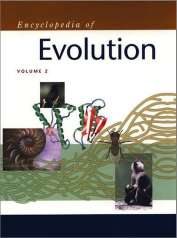 Stephen Jay Gould's account of macroevolution in a new Encyclopedia of Evolution interests us. He argues that the basic Darwinian mechanisms that produce microevolution do not adequately account for some of the more substantial steps in evolution, and we emphatically agree. He observes, "An anatomically degenerate parasite, reduced by natural selection to little more than a bag of reproductive tissue in the body of a host, may be just as well adapted to it's local environment as the most admirably evolved organic machine for running, swimming, or flying" (p E-26). Again we agree.
Stephen Jay Gould's account of macroevolution in a new Encyclopedia of Evolution interests us. He argues that the basic Darwinian mechanisms that produce microevolution do not adequately account for some of the more substantial steps in evolution, and we emphatically agree. He observes, "An anatomically degenerate parasite, reduced by natural selection to little more than a bag of reproductive tissue in the body of a host, may be just as well adapted to it's local environment as the most admirably evolved organic machine for running, swimming, or flying" (p E-26). Again we agree.
Then he offers two detailed examples in which additional mechanisms would be needed to explain macroevolution. The first one invokes genetic "hitchhiking" to promote a trend towards smaller body size along with an advantageous trait such as a higher speciation rate. (Do changes in body size exemplify macroevolution?) In Gould's second example, catastrophic mass extinctions explain the emergence and dominance of species that might remain subordinate or go extinct under normal circumstances. Neither of Gould's examples deals with macroevolutionary progress, but only backward steps — reduced body size or extinction. He offers no account for the new genetic programs needed to produce "running, swimming, or flying." In our opinion, this lack is symptomatic of the big flaw in the darwinian account of evolution: it does not adequately account for sustainable macroevolutionary progress. (Why doesn't Gould mention horizontal gene transfer?) Gould's six-page essay, "Macroevolution," is one of nine "Overview Essays" by distinguished scientists introducing the new, two-volume encyclopedia. Among its roughly 350 entries, "panspermia" is not included.
 Encyclopedia of Evolution, Mark D. Pagel, ed., 1326 pages (2 vols.), ISBN: 0195122003, Oxford University Press, 2002. Encyclopedia of Evolution, Mark D. Pagel, ed., 1326 pages (2 vols.), ISBN: 0195122003, Oxford University Press, 2002.
 Neo-Darwinism... includes a related section, "Does Microevolution Explain Macroevolution?". Neo-Darwinism... includes a related section, "Does Microevolution Explain Macroevolution?".
 Macroevolutionary Progress Redefined... is a related CA webpage. Macroevolutionary Progress Redefined... is a related CA webpage.
April 2
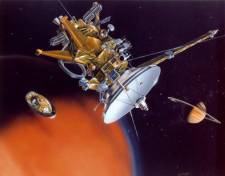 Is Titan's methane biological? The European Space Agency (ESA) says maybe so. Something keeps replacing it in Titan's atmosphere, and nonbiological process that could produce the needed quantities are not known. ESA's Huygens probe, arriving at Titan in 2005, should help find answers. [Thanks, Larry Klaes.]
Is Titan's methane biological? The European Space Agency (ESA) says maybe so. Something keeps replacing it in Titan's atmosphere, and nonbiological process that could produce the needed quantities are not known. ESA's Huygens probe, arriving at Titan in 2005, should help find answers. [Thanks, Larry Klaes.]
 Splashing down on Titan's oceans, ESA, 1 April 2003. Splashing down on Titan's oceans, ESA, 1 April 2003.
 Life on Europa... is a CA webpage with links to What'sNEW for life on moons and planets (except Mars). Life on Europa... is a CA webpage with links to What'sNEW for life on moons and planets (except Mars).
March 31
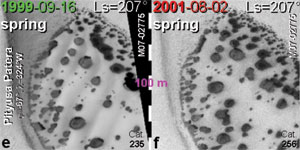 Changing dark spots on Mars biological? A team of Hungarian scientists reinforce the case in a paper presented this month at the Lunar and Planetary Science Conference in Houston TX. Dark Dune Spots (DDSs) have been observed on the Mars Orbiter Camera narrow angle images from 1998 to 2002. They are especially interesting because they change with Mars' seasons; and now, water has been detected in the ground near them. Gánti et al. suggest that the seasonal changes in the dark spots can be explained if "in winter the first rays of sunlight activate the MSOs [Mars Surface Organisms], they start to warm up and melt the H2O ice around them, while above them sublimation of CO2 on the top of the frost is accelerated. Later MSOs begin to grow and reproduce themselves in the water melted by them. Complete defrosting of the water ice cover stops shielding the MSOs and water immediately evaporates, too, on this unprotected region, hence the life conditions of MSOs cease and they desiccate." [Thanks, Larry Klaes.]
Changing dark spots on Mars biological? A team of Hungarian scientists reinforce the case in a paper presented this month at the Lunar and Planetary Science Conference in Houston TX. Dark Dune Spots (DDSs) have been observed on the Mars Orbiter Camera narrow angle images from 1998 to 2002. They are especially interesting because they change with Mars' seasons; and now, water has been detected in the ground near them. Gánti et al. suggest that the seasonal changes in the dark spots can be explained if "in winter the first rays of sunlight activate the MSOs [Mars Surface Organisms], they start to warm up and melt the H2O ice around them, while above them sublimation of CO2 on the top of the frost is accelerated. Later MSOs begin to grow and reproduce themselves in the water melted by them. Complete defrosting of the water ice cover stops shielding the MSOs and water immediately evaporates, too, on this unprotected region, hence the life conditions of MSOs cease and they desiccate." [Thanks, Larry Klaes.]
 T. Gánti et al., "Evidence for Water by Mars Odyssey Is Compatible with a Biogenic DDS Formation Process" [pdf], 34th Lunar and Planetary Science Conference, 2003. T. Gánti et al., "Evidence for Water by Mars Odyssey Is Compatible with a Biogenic DDS Formation Process" [pdf], 34th Lunar and Planetary Science Conference, 2003.
 34th Lunar and Planetary Science Conference, Houston TX, 17-21 March 2003. 34th Lunar and Planetary Science Conference, Houston TX, 17-21 March 2003.
 2002, Jan 31: "More about the changing dark spots..." is a related What'sNEW item. 2002, Jan 31: "More about the changing dark spots..." is a related What'sNEW item.
 2001, Sep 7: "Dark spots which spread every Martian spring..." is a related What'sNEW item. 2001, Sep 7: "Dark spots which spread every Martian spring..." is a related What'sNEW item.
 Life on Mars! is a related CA webpage. Life on Mars! is a related CA webpage.
March 29
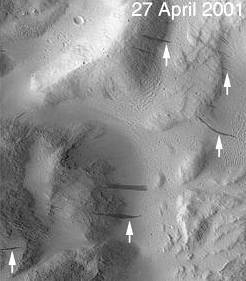 More about the fresh dark streaks on Mars — Newly available photos from NASA show many more examples of fresh dark streaks in the vicinity of Mars' Olympus Mons volcano. For example, the photo at right shows dark streaks that were not present when the same area was photographed 20 months earlier. The streaks resemble meltwater and may nourish life. [Thanks, Larry Klaes.]
More about the fresh dark streaks on Mars — Newly available photos from NASA show many more examples of fresh dark streaks in the vicinity of Mars' Olympus Mons volcano. For example, the photo at right shows dark streaks that were not present when the same area was photographed 20 months earlier. The streaks resemble meltwater and may nourish life. [Thanks, Larry Klaes.]
* photo credit: NASA/JPL Malin Space Science Systems.
* photo dimensions: approximately 3 by 3.5 km.
 Mars Water, Odd Surface Features Tied to Life, by Leonard David, Space.com, 28 Mar 2003. Mars Water, Odd Surface Features Tied to Life, by Leonard David, Space.com, 28 Mar 2003.
 Mars Gullies Could Harbor Martian Biology, by Leonard David, Space.com, 7 Apr 2003. Mars Gullies Could Harbor Martian Biology, by Leonard David, Space.com, 7 Apr 2003.
 2003, March 14: "Water flowing on Mars now?" is a related What'sNEW item. 2003, March 14: "Water flowing on Mars now?" is a related What'sNEW item.
 Life on Mars! is a related CA webpage. Life on Mars! is a related CA webpage.
March 25
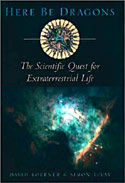 Here Be Dragons, by an astronomer and a biologist, is about the Search for Exrtraterrestrial Intelligence (SETI). If that subject interests you at all, we recommend this book. Of its ten chapters, two especially interest us as well, "Origins" (ch. 1), and "What Happens in Evolution?" (ch. 6).
Here Be Dragons, by an astronomer and a biologist, is about the Search for Exrtraterrestrial Intelligence (SETI). If that subject interests you at all, we recommend this book. Of its ten chapters, two especially interest us as well, "Origins" (ch. 1), and "What Happens in Evolution?" (ch. 6).
Chapter 1 begins with a visit to The Museum of Creation and Earth History, and moves to a well-paced, informative history of origin-of-life research. That the chemical ingredients of life may have been delivered from space (pseudo-panspermia) is now a completely respectable hypothesis, we read. Also, eminent researcher Leslie Orgel "believes that living organisms may travel from world to world." But he remarks, "All theories are bad."
Chapter 6, subtitled "Chance and Necessity in the Origin of Biological Complexity," is based on interviews with Orgel, Gerald Joyce, Stuart Kauffman, Stephen Jay Gould and Simon Conway Morris. Here we noticed an example of a longstanding confusion: in fitness landscapes, what does the vertical axis measure? The authors state plainly, "The height of the landscape at each point represents the 'fitness' of that possible organism: roughly speaking, how many offspring is it likely to leave." If so, of course, simpler lifeforms like bacteria would occupy the peaks. But the authors promptly say that the challenge of ascending the peaks is a different one: "How do you get complex structures like eyes?" So now the vertical axis measures organized complexity? But the two measures — likely number of surviving offspring, and organized complexity — are almost diametrically opposed. This confusion can mislead us into thinking that if mutations can increase "fitness," they can also increase organized complexity. Yet the latter phenomenon lacks experimental confirmation.
 Here Be Dragons: The Scientific Quest for Extraterrestrial Life, by David W. Koerner and Simon Levay, ISBN: 019514600X, Oxford University Press, 2000. Here Be Dragons: The Scientific Quest for Extraterrestrial Life, by David W. Koerner and Simon Levay, ISBN: 019514600X, Oxford University Press, 2000.
 Thanks for the book, Dave Bowman! Thanks for the book, Dave Bowman!
 Neo-Darwinism... is a related CA webpage with some links about Fitness Landscapes in the Genetics: What'sNEW section. Neo-Darwinism... is a related CA webpage with some links about Fitness Landscapes in the Genetics: What'sNEW section.
March 24
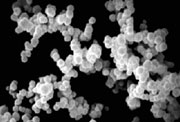 Nanobacteria continue to puzzle science. They seem too small to contain the minimal machinery for cells, yet they exhibit characteristics of life. Even the name, instead of "nanobes," for example, is questionable. They became more interesting when fossilized ones were observed in the famous Mars meteorite, ALH84001, in 1996.
Nanobacteria continue to puzzle science. They seem too small to contain the minimal machinery for cells, yet they exhibit characteristics of life. Even the name, instead of "nanobes," for example, is questionable. They became more interesting when fossilized ones were observed in the famous Mars meteorite, ALH84001, in 1996.
 Small World, by Stephen Hart, Astrobiology Magazine, 24 Mar 2003. Small World, by Stephen Hart, Astrobiology Magazine, 24 Mar 2003.
 Life on Mars! is a CA webpage with more on nanobes. Life on Mars! is a CA webpage with more on nanobes.
March 23
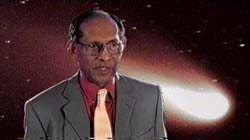 Wales television features Chandra Wickramasinghe in a special program about his lifelong investigation of the theory that life on Earth came from space. The special was filmed mostly in Sri Lanka, and Arthur Clarke also appears in it. A brief Internet version can [no longer] be downloaded.
Wales television features Chandra Wickramasinghe in a special program about his lifelong investigation of the theory that life on Earth came from space. The special was filmed mostly in Sri Lanka, and Arthur Clarke also appears in it. A brief Internet version can [no longer] be downloaded.
 Wales This Week: A Space Odyssey, 13 Mar 2003. Wales This Week: A Space Odyssey, 13 Mar 2003.
 Introduction... is a related CA webpage. Introduction... is a related CA webpage.
 Chandra Wickramasinghe... is a related CA webpage. Chandra Wickramasinghe... is a related CA webpage.
March 14
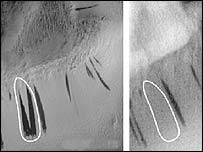 Water flowing on Mars now? — Tahirih Motazedian, of the University of Oregon, examined images of Mars taken at different times and noticed that new streaks form within months. She speculates that volcanic heat may melt subsurface ice, releasing a brine onto the martian slopes. "The streaks originate from distinct geologic horizons below the Martian surface, where the water-ice table has been intersected by crater and valley walls," she said. [Thanks, Sciquest.]
Water flowing on Mars now? — Tahirih Motazedian, of the University of Oregon, examined images of Mars taken at different times and noticed that new streaks form within months. She speculates that volcanic heat may melt subsurface ice, releasing a brine onto the martian slopes. "The streaks originate from distinct geologic horizons below the Martian surface, where the water-ice table has been intersected by crater and valley walls," she said. [Thanks, Sciquest.]
 Water 'flows' on Mars, by David Whitehouse, BBCNews online, 13 Mar 2003. Water 'flows' on Mars, by David Whitehouse, BBCNews online, 13 Mar 2003.
 2003, February 5: "Small gullies on Mars" is a related What'sNEW item. 2003, February 5: "Small gullies on Mars" is a related What'sNEW item.
 Life on Mars! is a related CA webpage. Life on Mars! is a related CA webpage.
March 12
More on transposable elements (TEs) — Their role in evolution is reviewed by Margaret Kidwell and Damon Lisch in the journal Evolution. The writers discuss the full range of different characterizations of TEs, from parasitic to symbiotic. Their article cites over 250 earlier articles, and is now a near-classic. Its observations include —
- Barbara McClintock dicovered TEs in maize the 1940s, naming them "controlling elements" because they were able "to regulate gene expression in precise ways."
- TEs can ...make significant contributions to the evolution of their hosts.
- TEs are DNA sequences that have the capacity to change genomic locations.... Initially there is a rapid invasion phase....
- Class I TE's — retrotransposons, retroposons, and retrointrons — are similar to retroviruses, using an RNA-mediated mode of transposition, and encoding a reverse transcriptase. Class II TEs — transposons as originally, narrowly defined — use a DNA-mediated mode of transposition.
- Identifiable TEs make up approximately 35% of the genome of [humans]... and possibly as much as 50%.
- TEs can be transferred horizontally between species.... The specific mechanisms responsible for horizontal transfer of TEs remain elusive.
- Parasitic elements, such as transposons and introns, might have provided the genes responsible for the sexual cycle in eukaryotic organisms.
- TEs may have played a major role in... the origin of eukaryotes and the origin of vertebrates...[by providing] the driving force for... chromatin formation and methylation.
- Although simple DNA base substitutions are well suited for the generation, diversification, and optimization of local protein space..., a hierarchy of mutational events is required for the rapid generation of protein diversity.... Because they are uniquely competent to reshuffle DNA sequences, TEs and viruses are important generators of the more complex types of mutations in the mutational hierarchy.
- TEs may play a significant role in genome reorganization by promoting the insertion of other gene sequences....
- There is evidence for specific targetting [by TEs] of some heterochromatic regions.... Different elements have distinct insertional preferences.... Heterochromatin proteins can recognize and silence transposable elements.
- Recruitment may occur long after the elements entered the host genome; these sequences may even have lost some of the features that distinguish them as of TE origin.
- The propensity of these elements to insert into (and in some cases, even make up) the regulatory regions of genes... suggests an important role in host regulatory evolution.
- A series of TE-associated mutations exemplifies the potenetal for TE-mediated "rewiring" of regulatory networks.
- The adaptive integration of a short piece of DNA into a complex regulatory network... might be considered to represent an evolutionary process that has been common in the evolution of increasingly complex forms of life.
Kidwell and Lisch interpret these observations within a darwinian framework. However, they do not propose any means whereby TEs might have become capable of, for example, rewiring regulatory networks in such a precise and inventive way. And how does darwinism explain the "recruitment" of these sequences? We suggest that TEs participate in the acquisition and installation of new programs in a genetically open environment, using protocols not yet understood.
 Margaret G. Kidwell and Damon R. Lisch, "Perspective: Transposable Elements, Parasitic DNA, and Genome Evolution," p 1-24 v 55 Evolution: Int J Org Evolution, Jan 2001. Margaret G. Kidwell and Damon R. Lisch, "Perspective: Transposable Elements, Parasitic DNA, and Genome Evolution," p 1-24 v 55 Evolution: Int J Org Evolution, Jan 2001.
 Transposable Elements — from a syllabus by Stanley Maloy, University of Illinois, Urbana-Champaign. Transposable Elements — from a syllabus by Stanley Maloy, University of Illinois, Urbana-Champaign.
 Viruses... is a CA webpage about horizontal gene transfer and related phenomena. [Next-What'sNEW about HGT-Prev] Viruses... is a CA webpage about horizontal gene transfer and related phenomena. [Next-What'sNEW about HGT-Prev]
 2003, February 20: ...TEs contribute to human evolution. 2003, February 20: ...TEs contribute to human evolution.
March 10
New target for Rosetta — The ESA spacecraft was to launch in January, rendezvous with comet Wirtanen in 2012, and land a probe on its surface. But after its launcher failed in December, the mission was cancelled. Now ESA has selected comet 67P/Churyumov-Gerasimenko — nicknamed "Chury" — as the target. Rosetta could be launched as soon as February 2004, with the rendezvous in about 2014. The choice of Rosetta's target will not be officially made by ESA's Science Policy Committee until the end of May, as some final details remain to be worked out.
 New target for comet-chasing mission identified, NewScientist.com, 3 Mar 2003. New target for comet-chasing mission identified, NewScientist.com, 3 Mar 2003.
 Comet Rendezvous is the related section of the CA webpage, "Can the Theory Be Tested." Comet Rendezvous is the related section of the CA webpage, "Can the Theory Be Tested."
March 3
 What Evolution Is — Ernst Mayr, Professor Emeritus in the Museum of Comparative Zoology at Harvard University, is perhaps the most distinguished evolutionary authority alive today. Not many others would have the standing to name a book What Evolution Is. For an explication and defense of Darwinsm, one can't do better. In it Mayr gives a lengthy list of evidence that evolution has occurred, because one of his intended audiences is the creationists. Mayr is especially insightful about Charles Darwin, as when he deconstructs Darwinism into five major theories (p 86). While the writing is clear and easy, the book is a deep resource, including a glossary of 175 words, a ten-page bibliography, and a fifteen-page index.
What Evolution Is — Ernst Mayr, Professor Emeritus in the Museum of Comparative Zoology at Harvard University, is perhaps the most distinguished evolutionary authority alive today. Not many others would have the standing to name a book What Evolution Is. For an explication and defense of Darwinsm, one can't do better. In it Mayr gives a lengthy list of evidence that evolution has occurred, because one of his intended audiences is the creationists. Mayr is especially insightful about Charles Darwin, as when he deconstructs Darwinism into five major theories (p 86). While the writing is clear and easy, the book is a deep resource, including a glossary of 175 words, a ten-page bibliography, and a fifteen-page index.
We were especially interested Mayr's account of the origin of new genes, which he names as a subtopic (p 38). He blithely explains that new genes are produced "most frequently, by the doubling of an existing gene," as if this theory were as well established as the structure of DNA. Actually, it was never well-established, and recent evidence casts doubt on it. But apparently, Mayr is not really very interested in the genetics underlying evolution. At one point he has the genomes of humans and bacteria too small by a factor of 1,000 (p 107), although he has them right elsewhere (p 38). He even writes, "It was one of the unexpected happy discoveries of molecular biology that molecules evolve just the same as do somatic structures" (p 34). He thought evolution could occur without genetic changes? And he mistakenly believes, "No selectively valuable contributions are known for any [transposable elements]" (p 100).
In Mayr's discussion of adaptation he writes, "new adaptations are ordinarily acquired quite gradually" (p 155). Later, about macroevolution he again emphasizes gradualness (p 190). Then he writes, "In spite of its gradualness, macroevolution is characterized by numerous major inventions..." (p 203). He is not concerned that this gradualism would somehow have to be tied to gradualism at the genetic level. That is, genes would have to gradually acquire the programs for those new inventions. But this gradual re-programming process has not been observed, nor has good evidence for it accumulated. Mayr ignores this problem completely. But so does almost everybody.
 What Evolution Is, by Ernst Mayr, foreword by Jared Diamond, 318 pages, Basic Books, 2001. What Evolution Is, by Ernst Mayr, foreword by Jared Diamond, 318 pages, Basic Books, 2001.
 Interview with Ernst Mayr, Edge.org, 31 Oct 2001. Interview with Ernst Mayr, Edge.org, 31 Oct 2001.
 2003, January 17: Duplicated genes serve backup functions. 2003, January 17: Duplicated genes serve backup functions.
 2000, June 12: Ernst Mayr does not doubt evolutionary progress — in the What'sNEW archives. 2000, June 12: Ernst Mayr does not doubt evolutionary progress — in the What'sNEW archives.
 Neo-Darwinism... is a related CA webpage. Neo-Darwinism... is a related CA webpage.
 Can Computers Mimic... Evolution? discusses gene duplication. Can Computers Mimic... Evolution? discusses gene duplication.

|